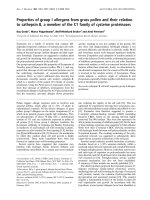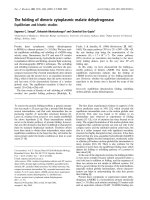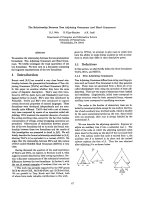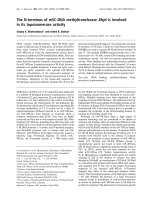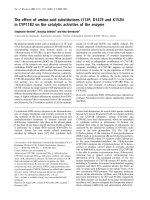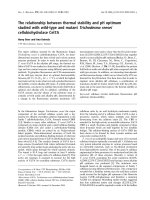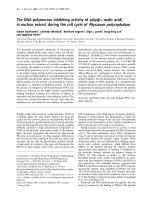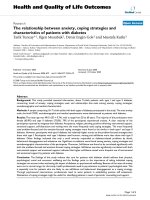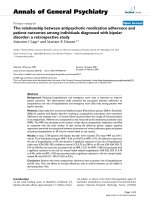Báo cáo y học: "The relationship between disease activity, sleep, psychiatric distress and pain sensitivity in rheumatoid arthritis: a cross-sectional study" docx
Bạn đang xem bản rút gọn của tài liệu. Xem và tải ngay bản đầy đủ của tài liệu tại đây (293.01 KB, 11 trang )
Open Access
Available online />Page 1 of 11
(page number not for citation purposes)
Vol 11 No 5
Research article
The relationship between disease activity, sleep, psychiatric
distress and pain sensitivity in rheumatoid arthritis: a
cross-sectional study
Yvonne C Lee
1
, LoriBChibnik
1
, Bing Lu
1
, Ajay D Wasan
2
, Robert R Edwards
2
, Anne H Fossel
1
,
Simon M Helfgott
1
, Daniel H Solomon
1
, Daniel J Clauw
3
and Elizabeth W Karlson
1
1
Division of Rheumatology, Immunology and Allergy, Brigham and Women's Hospital, 75 Francis Street, PBB-B3, Boston, MA, 02115, USA
2
Pain Management Center, Brigham and Women's Hospital, 850 Boylston Street, Chestnut Hill, MA, 02467, USA
3
Chronic Pain and Fatigue Center, University of Michigan Medical School, Domino's Farms, Lobby M, PO Box 385, 24 Frank Lloyd Wright Drive, Ann
Arbor, MI, 48106, USA
Corresponding author: Yvonne C Lee,
Received: 14 Jul 2009 Revisions requested: 27 Aug 2009 Revisions received: 23 Sep 2009 Accepted: 29 Oct 2009 Published: 29 Oct 2009
Arthritis Research & Therapy 2009, 11:R160 (doi:10.1186/ar2842)
This article is online at: />© 2009 Lee et al.; licensee BioMed Central Ltd.
This is an open access article distributed under the terms of the Creative Commons Attribution License ( />),
which permits unrestricted use, distribution, and reproduction in any medium, provided the original work is properly cited.
Abstract
Introduction Despite recent advances in anti-inflammatory
therapy, rheumatoid arthritis (RA) patients continue to rate pain
as a priority. The etiology of RA pain is likely multifactorial,
including both inflammatory and non-inflammatory components.
In this study, we examine the association between disease
activity, sleep, psychiatric distress and pain sensitivity in RA.
Methods Fifty-nine female RA patients completed
questionnaires and underwent pressure pain threshold testing
to assess hyperalgesia/allodynia at joint and non-joint sites.
Blood samples were taken to measure C-reactive protein (CRP).
The association between disease activity, sleep problems,
psychiatric distress and pain threshold was assessed using
Pearson/Spearman correlations and multivariable linear
regression. Disease activity levels, sleep problems and
psychiatric distress were compared between RA patients with
fibromyalgia and RA patients without fibromyalgia.
Results In unadjusted analyses, CRP was not correlated with
pain threshold, but tender joint count was inversely correlated
with pain threshold at all sites (P ≤ 0.004). Sleep problems were
associated with low pain threshold at all sites (P ≤ 0.0008).
Psychiatric distress was associated with low pain threshold at
the wrist and thumbnail (P ≤ 0.006). In multivariable linear
regression models, CRP was inversely associated with wrist
pain threshold (P = 0.003). Sleep problems were inversely
associated with pain threshold at all sites (P ≤ 0.01), but
psychiatric distress was not. Despite differences in pain
threshold, CRP levels and sleep problems between RA patients
with fibromyalgia and those without fibromyalgia, associations
between these variables did not change when patients with
fibromyalgia were excluded.
Conclusions Multivariable models are essential in analyses of
pain. Among RA patients, inflammation is associated with
heightened pain sensitivity at joints. In contrast, poor sleep is
associated with diffuse pain sensitivity, as noted in central pain
conditions such as fibromyalgia. Future studies examining pain
sensitivity at joint and non-joint sites may identify patients with
different underlying pain mechanisms and suggest alternative
approaches to treating RA pain.
Introduction
Rheumatoid arthritis (RA) is a chronic inflammatory disease
that causes significant pain. Despite the development of effec-
tive medications to treat inflammation, pain remains a priority
for RA patients [1,2]. Many RA patients report pain at non-joint
sites, suffering from ongoing pain even when inflammation
appears to be well controlled [3].
To date, most studies of pain in RA have focused on clinical
pain severity. Kojima and colleagues recently reported inde-
anti-CCP: anti-cyclic citrullinated peptide; BPI-sf: Brief Pain Inventory - short form; CRP: C-reactive protein; DAS28: disease activity score in 28 joints;
DMARD: disease-modifying anti-rheumatic drug; ELISA: enzyme-linked immunosorbent assay; HADS: Hospital Anxiety and Depression Scale; ICC:
intraclass correlations; MOS: Medical Outcomes Study; NSAID: non-steroidal anti-inflammatory drug; RA: rheumatoid arthritis; RF: rheumatoid factor;
SD: standard deviation; TNF: tumor necrosis factor.
Arthritis Research & Therapy Vol 11 No 5 Lee et al.
Page 2 of 11
(page number not for citation purposes)
pendent effects of depression severity and inflammation on
perceived pain in RA patients, emphasizing the complex rela-
tion between pain, inflammation and psychiatric distress [4].
An earlier, cross-sectional study showed strong associations
between clinical pain severity, sleep disturbance and mood
[5]. Although these studies provided critical information
regarding clinical factors associated with pain severity, they
did not quantify the patients' underlying pain sensitivity or yield
information about pain mechanisms.
Pain sensitivity is measured by responses to experimental
stimuli such as pressure. High pain thresholds represent low
pain sensitivity, whereas low pain thresholds represent high
pain sensitivity [6-8]. Increased pain in response to normally
painful stimuli is termed hyperalgesia, whereas pain in
response to normally non-painful stimuli is termed allodynia.
Pain thresholds may be measured at different locations to yield
a comprehensive assessment of pain sensitivity at joint and
non-joint sites [9].
Although it is well-documented that RA patients have lower
pain thresholds than healthy controls [6,10-16], little is known
about the factors associated with low pain thresholds and
whether these factors impact pain thresholds on a peripheral,
local level (i.e. at the joints) or on a central, widespread level.
No studies of RA patients have incorporated assessments of
pain threshold with comprehensive assessments of sleep
problems and psychiatric distress, although these factors are:
associated with reported pain severity [17-22] and low pain
threshold [23-27] among healthy individuals and individuals
with non-inflammatory pain syndromes; prevalent among the
RA population [5,28-31]; and associated with reported pain
severity among RA patients [32-37].
As differences in pain sensitivity may shape the course of pain
complaints and influence treatment decisions [38], it is impor-
tant to understand the factors associated with enhanced pain
sensitivity. In this study, we examined the relation between dis-
ease activity, sleep, psychiatric distress and pain threshold in
RA patients. We hypothesized that both inflammatory and non-
inflammatory factors are important mediators of pain sensitiv-
ity. Specifically, we hypothesized that objective measures of
disease activity, such as C-reactive protein (CRP), are associ-
ated with pain threshold at RA-affected joints but not at sites
distant from joints. We hypothesized that sleep and psychiat-
ric distress are associated with decreased pain threshold at all
sites, as is seen in chronic, non-inflammatory pain conditions
such as fibromyalgia.
Materials and methods
Patients
Female RA patients were recruited from an academic medical
institution from February to July 2008. Inclusion criteria were:
RA diagnosed by a board-certified rheumatologist and female
sex. The study was limited to women because men and
women have different pain thresholds and must be analyzed
separately. Because 82% of RA patients at this academic
institution are women, we were underpowered to study men.
Participants were excluded if they had taken opiate medica-
tions within one week of the study. The study was approved by
the Partners Institutional Review Board. All participants pro-
vided written informed consent.
Pressure pain threshold measurements
Participants wore large gloves to blind the investigator to dis-
ease activity in the hands. A rheumatologist (YCL) trained in
algometry assessed pressure pain threshold using a Wagner
FPK 20 algometer (Wagner Instruments, Greenwich, CT,
USA) at joints (wrists), sites close to joints (thumbnails) and
sites distant from joints (trapezius muscles). The investigator
explained the procedure using a standard script. A trial run
was performed to accustom participants to the procedure.
Testing began at the thumbnails, continued at the wrists and
ended at the trapezius muscles. All measurements were per-
formed bilaterally, right side first. The investigator increased
the pressure at a rate of 1 kg/s to a maximum of 11 kg. The
pain threshold was defined as the pressure at which partici-
pants first indicated pain. After a five minute rest/equilibrium
period, testing was repeated.
Assessment of clinical variables
Disease activity was measured by high sensitivity CRP, swol-
len and tender joint counts and the disease activity score in 28
joints (DAS28). High sensitivity CRP was chosen because the
range of CRP concentrations varies greatly among RA
patients, and this assay is capable of measuring both low and
high concentrations of CRP. Sleep problems were quantified
using the Sleep Problems Index II of the Medical Outcomes
Study (MOS) sleep scale, a validated, 12-item questionnaire
that assesses sleep problems in chronically ill populations
[39]. Psychiatric distress was measured using the Hospital
Anxiety and Depression Scale (HADS), a validated 14-item
questionnaire that assesses depression and anxiety in physi-
cally ill patients [40]. Participants also completed the Brief
Pain Inventory - short form (BPI-sf), a validated, nine-question
survey, to characterize clinical pain severity [41].
Disease duration and medication use were obtained by patient
self-report. Rheumatoid factor (RF) and anti-cyclic citrullinated
peptide (anti-CCP) levels were obtained from chart review.
Participants were classified as RF positive if they had a RF
level of 15 IU/ml or higher (nephelometry) or if their rheumatol-
ogist documented RF seropositivity in the medical chart. Par-
ticipants were classified as anti-CCP positive if they had an
anti-CCP level of 5 U/ml or higher (second-generation Axis
Shield DIASTAT™ ELISA assay) or if their rheumatologist doc-
umented anti-CCP seropositivity in the medical chart. All data
were double-entered by two individuals and checked against
each other for accuracy.
Available online />Page 3 of 11
(page number not for citation purposes)
Statistical testing
The reproducibility of algometry measurements was assessed
by intraclass correlations (ICCs) and percent change in pain
threshold. For all analyses of association, we used the mean
pain threshold between the first and second trials and the left
and right side. The distributions of all variables were examined.
Means and standard deviations (SDs) were calculated for nor-
mally distributed variables. Minimum, median and maximum
values were reported for variables that were not normally dis-
tributed.
Plots of pain threshold versus clinical variables were examined
for non-linear relations. Pearson and Spearman coefficients
were used to examine the unadjusted associations between
clinical variables and pain threshold at each site. Correlation
coefficients between -0.3 and 0.3 were interpreted as no to
low association. Coefficients between -0.3 and -0.6 were con-
sidered moderate inverse associations, and coefficients below
-0.6 suggested strong inverse associations.
In multivariable linear regression models, we examined the
combined effect of disease activity, sleep problems and psy-
chiatric distress on pain threshold at each site. Because com-
posite measures (i.e., DAS28-CRP) are influenced by
subjective measures of tenderness unrelated to inflammation
[38], we chose CRP as the measure of disease activity in
these models. We chose the total HADS score to represent
psychiatric distress because it assesses both depression and
anxiety. We adjusted all analyses for age, given previous stud-
ies suggesting an association between pain threshold and age
[42]. We also included covariates associated with pain thresh-
old at P < 0.1 in unadjusted analyses. Non-linear relations
were assessed by adding higher order polynomials to the final
multivariable model. Given the strong association between
total HADS score and MOS sleep score, post-hoc analyses
were performed to determine whether the results would
change if either variable were removed from the model.
Because psychiatric distress and sleep problems may identify
a subset of RA patients with fibromyalgia rather than pertain to
RA patients as a whole, we calculated the median total HADS
score and median MOS sleep score among RA patients with
fibromyalgia (defined by ≥ 11 tender points) and compared
them in tabular form to the group of RA patients with less than
11 tender points. We also compared the mean pain thresholds
of RA patients with and without 11 or more tender points. For-
mal statistical testing was not performed due to the small
number of patients with 11 or more tender points. To further
assess these relations, we inserted two-way interaction terms
in the final models to determine whether the relations between
inflammation, sleep problems, psychiatric distress and pain
threshold differed based on the presence of 11 or more tender
points. To confirm that these relations remained the same
among RA patients who had less than 11 tender points, we
ran the final model, excluding participants with 11 or more ten-
der points.
The strength of association was assessed using regression
coefficients (β) and P values. The β coefficient represents the
change in outcome given a one unit change in the predictor,
holding all other variables constant. The threshold for signifi-
cance was set as a two-tailed P < 0.05. All analyses were per-
formed using the SAS 9.1 software package (SAS Institute,
Cary, NC, USA).
Results
Patient characteristics
Fifty-nine female RA patients participated in this study (Table
1). Mean age was 61.0 ± 15.2 years and 89.8% were Cauca-
sian. The median BPI-sf pain severity score was 3.0, and
37.3% had wrist swelling consistent with synovitis. Of the 59
patients, 67.8% were treated with a synthetic disease-modify-
ing anti-rheumatic drug (DMARD), 62.7% were treated with a
biologic DMARD, and 40.7% were treated with both synthetic
and biologic DMARDs.
Pressure pain thresholds
Mean pain thresholds were lowest at the trapezius muscles
(right: 4.3 ± 1.9 kg/cm
2
; left: 4.4 ± 2.2 kg/cm
2
) and highest at
the thumbnails (right: 5.5 ± 2.7 kg/cm
2
; left: 5.3 ± 2.6 kg/
cm
2
). Percent change in pain threshold between tests 1 and 2
ranged from -8.3 ± 29.7% to 3.6 ± 28.2%. ICCs ranged
between 0.80 and 0.92 (Table 2). Correlations between pain
thresholds and reported pain severity, measured by the BPI-sf
pain severity score, ranged from -0.25 at the trapezius to -0.35
at the wrists.
Unadjusted associations between clinical variables and
pressure pain thresholds
Disease activity variables
CRP was not significantly associated with pain threshold at
any site. Swollen joint count was inversely associated with
wrist pain threshold (r = -0.37, P = 0.004) but not with pain
threshold at the thumbnails or trapezius muscles. Tender joint
count was inversely associated with pain threshold at all sites
(wrist: r = -0.49, r = 0.0001; thumbnail: r = -0.37, P = 0.004;
trapezius: r = -0.36, P = 0.006), and DAS28-CRP was asso-
ciated with wrist and thumbnail pain threshold (wrist: r = -0.42,
P = 0.002; thumbnail: r = -0.29, P = 0.03; Table 3).
Sleep/psychiatric distress
The MOS sleep problems index II was inversely associated
with pain threshold at all sites (wrists: r = -0.51, P < 0.0001;
thumbnails: r = -0.44, P = 0.0005; trapezius: r = -0.43, P =
0.0008). The total HADS score, HADS depression score and
HADS anxiety score were significantly associated with pain
threshold at the wrists (total: r = -0.42, P = 0.0009; depres-
sion: r = -0.37, P = 0.004; anxiety: r = -0.34, P = 0.008) and
thumbnails (total: r = -0.35, P = 0.006; depression: r = -0.33,
Arthritis Research & Therapy Vol 11 No 5 Lee et al.
Page 4 of 11
(page number not for citation purposes)
P = 0.01; anxiety: r = -0.27, P = 0.04) but not at the trapezius
muscles (Table 3).
Other variables
Participants taking biologic DMARDs had significantly lower
mean wrist pain thresholds than participants not taking bio-
logic DMARDS (4.5 ± 1.9 kg/cm
2
vs. 5.8 ± 1.9 kg/cm
2
; P =
0.01). Non-steroidal anti-inflammatory drug (NSAID) use, syn-
thetic DMARD use or corticosteroid use was not associated
with pain threshold at any site. There was no association
between RF status, anti-CCP status or disease duration and
pain threshold at any site.
Table 1
Characteristics of 59 rheumatoid arthritis patients
Characteristics Value
Mean age in years (SD) 61.0 (15.2)
Median disease duration in years (min, max) 9.5 (1, 58.5)
Caucasian (N, %) 53 (89.8)
Rheumatoid factor positive (N, %) 32 (68.1)
1
Anti-cyclic citrullinated peptide positive (N, %) 26 (86.7)
1
Median tender joint count (min, max) 4.0 (0, 26)
Median swollen joint count (min, max) 4.0 (0, 24)
Median C-reactive protein in mg/L (min, max) 2.6 (0, 17.9)
Mean DAS28-CRP (SD) 3.4 (1.3)
Median Brief Pain Inventory - short form pain severity score (min, max) 3.0 (0, 10)
Median Medical Outcomes Study sleep score (min, max) 33.1 (0, 88.9)
Median Hospital Anxiety and Depression Scale anxiety score (min, max) 4.0 (0, 17)
Median Hospital Anxiety and Depression Scale depression score (min, max) 3.0 (0, 13)
Median Hospital Anxiety and Depression Scale total score (min, max) 7.0 (0, 29)
Synthetic disease modifying anti-rheumatic drug use (N, %) 40 (67.8)
Biologic disease modifying anti-rheumatic drug use (N, %) 37 (62.7)
Combination therapy with both a synthetic and a biologic disease modifying anti-rheumatic drug (N, %) 24 (40.7)
Non-steroidal anti-inflammatory drug use (N, %) 23 (39.0)
Corticosteroid use (N, %) 18 (30.5)
1
Percent of patients with recorded measurements (anti-cyclic citrullinated peptide: n = 30; rheumatoid factor: n = 47)
CRP = C-reactive protein; DAS28 = Disease Activity Score in 28 joints; SD = standard deviation.
Table 2
Reproducibility of pressure pain threshold measurements
Site Pressure pain threshold
Mean ± SD
(kg/cm
2
)
% change
1
± SD
Intraclass correlations
Right wrist 5.0 ± 2.1 -8.3 ± 29.7 0.80
Left wrist 5.0 ± 2.1 -4.0 ± 28.7 0.85
Right thumbnail 5.5 ± 2.7 3.6 ± 28.2 0.87
Left thumbnail 5.3 ± 2.6 -0.3 ± 25.0 0.90
Right trapezius 4.3 ± 1.9 -1.3 ± 27.9 0.83
Left trapezius 4.4 ± 2.2 -0.7 ± 22.2 0.92
1
Percentage change = (pain threshold
trial 1
- pain threshold
trial 2
)/pain threshold
trial 2
× 100%
SD = standard deviation.
Available online />Page 5 of 11
(page number not for citation purposes)
Multivariable associations between clinical variables
and pressure pain threshold
CRP was significantly inversely associated with wrist pain
threshold in multivariable analyses adjusted for age, sleep
problems, psychiatric distress and biologic DMARD use (β =
-0.15, P = 0.003). The association between CRP and thumb-
nail pain threshold was borderline significant (β = -0.13, P =
0.05). CRP was not significantly associated with trapezius
pain threshold. In multivariable models, the MOS sleep prob-
lems index II was significantly inversely associated with pain
threshold at all sites (wrists: β = -0.04, P = 0.007; thumbnails:
β = -0.06, P = 0.002, trapezius: β = -0.04, P = 0.01), but the
total HADS score was not significantly associated with pain
threshold at any site (Table 4).
When the total HADS score was removed from the multivaria-
ble model, the β-estimates for CRP and the MOS sleep prob-
lems index II did not change significantly. When the MOS
sleep problems index II was removed from the multivariable
model, the total HADS score became significantly associated
with pain threshold at all sites (wrist: β = -0.11, P = 0.001;
thumbnails: β = -0.09, P = 0.04; trapezius: β = -0.08, P =
0.04). CRP remained significantly associated with wrist pain
threshold (β = -0.13, P = 0.01).
Subgroup analyses of RA patients with and without 11 or
more tender points
RA patients with 11 or more tender points had more tender
joints, greater BPI-sf average pain severity scores and more
Table 3
Univariate association between clinical variables and pain threshold at the wrists, thumbnails and trapezius muscles
Variable Wrist pressure pain threshold Thumbnail pressure pain threshold Trapezius pressure pain threshold
r P value r P value r P value
Disease activity variables
C-reactive protein -0.24 0.09 -0.12 0.39 0.07 0.61
Swollen joint count -0.37 0.004 -0.18 0.16 -0.14 0.30
Tender joint count -0.49 0.0001 -0.37 0.004 -0.36 0.006
DAS28-CRP -0.42 0.002 -0.29 0.03 -0.20 0.16
Sleep
Medical Outcomes Study
Sleep
-0.51 < 0.0001 -0.44 0.0005 -0.43 0.0008
Psychosocial Variables
HADS - Total -0.42 0.0009 -0.35 0.006 -0.22 0.09
HADS - Depression -0.37 0.004 -0.33 0.01 -0.19 0.15
HADS - Anxiety -0.34 0.008 -0.27 0.04 -0.20 0.13
CRP = C-reactive protein; DAS28 = Disease Activity Score in 28 joints; HADS = Hospital Anxiety and Depression Scale.
Table 4
Independent association between clinical variables and pain threshold (multivariable linear regression analyses)
Variables Wrist pain threshold
1
Thumbnail pain threshold
1
Trapezius pain threshold
1
β
2
P value
β
2
P value
β
2
P value
C-reactive protein -0.15 0.003 -0.13 0.05 -0.03 0.55
Medical Outcomes Study Sleep Problems Index II -0.04 0.007 -0.06 0.002 -0.04 0.01
Hospital Anxiety and Depression Scale Total Score -0.03 0.48 0.01 0.80 -0.009 0.85
1
Separate models were run for wrist pain threshold, thumbnail pain threshold and trapezius pain threshold. All models included the three variables
above (C-reactive protein, Medical Outcomes Study Sleep Score, Hospital Anxiety and Depression Scale Total Score) and were adjusted for age
and biologic disease-modifying anti-rheumatic drug use.
2
The β-coefficient represents the change in the outcome (i.e., pain threshold) given a one unit change in the predictor, holding all other variables
constant. β-coefficients of different predictors cannot be directly compared because a one unit change in one predictor (i.e., 1 mg/ml change in
CRP) may be quite different from a one unit change in another predictor (i.e., one unit on the Medical Outcomes Study Sleep Score.
Arthritis Research & Therapy Vol 11 No 5 Lee et al.
Page 6 of 11
(page number not for citation purposes)
sleep problems than RA patients with less than 11 tender
points (Table 5 and Figure 1). CRP levels also appeared
higher among RA patients with 11 or more tender points.
Swollen joint counts and measures of psychiatric distress
were similar among the two groups (Table 5 and Figure 2).
Compared with RA patients with less than 11 tender points,
RA patients with 11 or more tender points had lower pain
thresholds at all sites (Table 6). There was no evidence for
two-way interactions between the presence of 11 or more ten-
der points and either CRP, the MOS sleep problems index II
or the HADS total score. When RA patients with 11 or more
tender points were excluded from the analysis, CRP remained
significantly associated with pain threshold at the wrists (β = -
0.15, P = 0.003). Sleep problems remained significantly asso-
ciated with pain threshold at all sites (wrists: β = -0.05, P =
0.0009; thumbnails: β = -0.05, P = 0.009, trapezius: β = -
0.04, P < 0.05).
Discussion
To our knowledge, this is the first study to show an inverse
association between CRP and joint pain threshold in RA. Our
study differed from previous studies because it focused on
pain threshold rather than clinical pain severity, and included
assessments of potential non-inflammatory predictors of pain
threshold, such as sleep problems and psychiatric distress.
Although unadjusted analyses did not reveal significant asso-
ciations between CRP and pain threshold, multivariable analy-
ses revealed a strong inverse association between CRP and
wrist pain threshold. These results suggest that variables,
such as sleep problems and psychiatric distress, may con-
found the association between wrist pain threshold and CRP,
emphasizing the need for multivariable models when studying
complex outcomes such as pain.
The pattern of association between clinical variables and pain
threshold at joint and non-joint sites provides novel insights
regarding pain mechanisms. Peripheral mechanisms, such as
peripheral sensitization, are characterized by local areas of
Figure 1
Histograms of the Medical Outcomes Study Sleep Problems Index II among RA patientsHistograms of the Medical Outcomes Study Sleep Problems Index II among RA patients. (a) Patients with less than 11 tender points (n = 43). (b)
Patients with 11 tender points or more (n = 15).
Available online />Page 7 of 11
(page number not for citation purposes)
hyperalgesia/allodynia in response to experimental induction
of inflammation [43,44], whereas central mechanisms have
widespread effects, involving both joint and non-joint sites.
Peripheral sensitization has been demonstrated in animals,
healthy individuals and individuals with RA [45], but the role of
central pain processing in RA has been largely understudied.
Studies involving healthy individuals and individuals with non-
inflammatory pain syndromes (i.e., fibromyalgia) have identified
two main mechanisms of widespread pain sensitivity: central
sensitization and loss of diffuse noxious inhibitory control
[46,47]. Central sensitization includes an acute phase involv-
ing sensitization of nociceptors in the spinal cord and a late
phase involving diffuse transcriptional changes in the central
nervous system [46,47]. Loss of diffuse noxious inhibitory con-
trols is characterized by diffuse hyperalgesia/allodynia due to
impairment of the descending pathways that normally induce
analgesia [47]. Evidence for central pain processing mecha-
nisms in RA include a small study (n = 12) showing altered
regional cerebral blood flow in the prefrontal cortex, cingulof-
rontal transition cortex and anterior cingulated cortex among
RA patients exposed to painful heat stimuli [48].
In our study, CRP was not associated with trapezius pain
threshold, arguing against an effect of systemic CRP on wide-
spread pain threshold. However, CRP was strongly associ-
ated with wrist pain threshold. This observation is consistent
with peripheral sensitization, leading to hyperalgesia at
Figure 2
Histogram of the Hospital Anxiety and Depression Scale (HADS) Total Score among RA patientsHistogram of the Hospital Anxiety and Depression Scale (HADS) Total Score among RA patients. (a) Patients with less than 11 tender points (n =
43). (b) Patients with 11 tender points or more (n = 15).
Arthritis Research & Therapy Vol 11 No 5 Lee et al.
Page 8 of 11
(page number not for citation purposes)
inflamed joints. The strength of association between CRP and
pain threshold decreased as the distance between RA-
affected joints and the site of pain threshold testing increased.
This gradient effect may be due to either the acute phase of
central sensitization, characterized by hyperalgesia extending
outside the area of direct inflammation [46], or a gradient in
local inflammatory mediators. We did not directly measure
local inflammatory mediators, but others have shown that
serum CRP levels reflect synovial fluid concentrations of
inflammatory cytokines [49,50].
These results are contrary to previous studies reporting no
association between inflammatory markers and pain threshold
[6,12,51] or a direct association between inflammatory mark-
ers and pain threshold [52]. These inconsistencies may be
due to differences in the sites of testing (i.e. joints vs. non-joint
sites) and/or confounding by other variables, such as sleep
problems and psychiatric distress.
Although CRP was only significantly associated with pain
threshold near RA-affected joints, sleep problems were asso-
ciated with low pain thresholds at all sites. These findings are
consistent with a previous study showing an association
between sleep disturbance and clinical pain severity among
RA patients [5]. The widespread pattern of association sug-
gests a central mechanism linking sleep disturbance and
hyperalgesia/allodynia. This hypothesis is supported by recent
studies showing that sleep deprivation (forced awakenings)
and short sleep duration are associated with impaired diffuse
noxious inhibitory controls among healthy women [22] and
individuals with temporomandibular joint disorder [53]. These
findings are particularly important given the high prevalence of
sleep disturbance among RA patients [5].
In contrast to a previous population-based study [23], our
study did not reveal a significant association between psychi-
atric distress and pain thresholds, after adjustment for sleep
problems. However, psychiatric distress was significantly
associated with pain threshold at the wrists and thumbnails in
unadjusted analyses, and psychiatric distress was significantly
associated with pain threshold at all sites in multivariable mod-
els that did not adjust for sleep problems. These results likely
reflect the strong correlation between sleep and psychiatric
distress (r = 0.65). Although pain thresholds were more
strongly associated with sleep problems than psychiatric dis-
tress in this study, it is not possible to untangle the cause-
effect relations due to the cross-sectional design.
The co-occurrence of heightened pain sensitivity, sleep prob-
lems and psychiatric distress is common among patients with
fibromyalgia, a chronic widespread pain condition that affects
approximately 17.1% of RA patients [54]. Given the high prev-
alence of fibromyalgia among RA patients and the known
associations between low pain thresholds, sleep problems
and psychiatric distress among fibromyalgia patients, it is pos-
Table 5
Clinical characteristics of RA patients with and without fibromyalgia (defined by ≥ 11 tender points)
Characteristics RA
(n = 43)
RA + FM
(n = 15)
Median tender joint count (min, max) 3.0 (0, 26) 7.0 (0, 21)
Median swollen joint count (min, max) 4.0 (0, 24) 4.0 (0, 23)
Median C-reactive protein in mg/L (min, max) 2.4 (0, 17.9) 3.7 (0, 10.6)
Mean DAS28-CRP (SD) 3.2 (1.3) 3.9 (1.2)
Median Brief Pain Inventory - short form pain severity score (min, max) 2.0 (0, 9) 5.0 (2, 10)
Median Medical Outcomes Study sleep score (min, max) 22.8 (0, 88.9) 40.6 (13.3, 68.9)
Median Hospital Anxiety and Depression Scale anxiety score (min, max) 4 (0, 15) 3 (0, 17)
Median Hospital Anxiety and Depression Scale depression score (min, max) 3 (0, 13) 2 (0, 12)
Median Hospital Anxiety and Depression Scale total score (min, max) 7 (0, 27) 7 (1, 29)
CRP = C-reactive protein; DAS28-CRP = Disease Activity Score in 28 joints; FM = fibromyalgia; RA = rheumatoid arthritis; SD = standard
deviation.
Table 6
Pain thresholds of RA patients with and without fibromyalgia
(defined by ≥ 11 tender points)
Characteristics RA
(n = 43)
RA + FM
(n = 15)
Mean wrist pain threshold (SD) 5.2 (2.0) 4.4 (1.8)
Mean thumbnail pain threshold (SD) 5.9 (2.5) 4.3 (2.3)
Mean trapezius pain threshold (SD) 4.6 (2.1) 3.6 (1.6)
FM = fibromyalgia; RA = rheumatoid arthritis; SD = standard
deviation.
Available online />Page 9 of 11
(page number not for citation purposes)
sible that our results were driven by the subgroup of patients
with fibromyalgia. Consistent with previous studies, our study
indicated that RA patients with 11 or more tender points had
increased sleep problems and lower pain thresholds than RA
patients with less than 11 tender points. However, the associ-
ations between pain threshold, CRP, sleep problems and psy-
chiatric distress remained the same after excluding patients
with 11 or more tender points from the analysis.
Similarly, we did not find any evidence for effect modification
by fibromyalgia on the association between pain threshold and
either CRP, the MOS sleep problems index II or the HADS
total score. These results were not surprising given recent
studies suggesting that widespread pain is a continuous spec-
trum rather than a discrete entity [55,56]. Scores from the
Symptom Intensity Scale, a validated instrument designed to
quantify widespread pain, are linearly associated with sleep
disturbance, depression, muscle pain and a variety of demo-
graphic and sociodemographic factors [55]. Although sleep
disturbance is associated with widespread pain, there is no
evidence that sleep disturbance has a differential effect on
pain threshold among patients with fibromyalgia compared
with those without fibromyalgia. However, we cannot exclude
the possibility that we were underpowered to see an effect.
This study is limited by its cross-sectional design, which
makes it impossible to determine the directionality of associa-
tions. While it is accepted that inflammation can lead to hyper-
algesia/allodynia in animal models and healthy humans
[43,44], this relation may be reversed, or even bidirectional, in
RA patients. For example, a recent study showed that TNF-α
levels increased after RA patients were exposed to painful
experimental stimuli. This phenomenon did not occur in healthy
controls [10].
The direction of association between pain threshold and sleep
problems is also unclear. Among fibromyalgia patients, path
analyses suggest that sleep predicts pain and not vice versa
[57]. However, RA pain differs from fibromyalgia pain because
RA pain frequently has an inflammatory component. Localized,
inflammatory pain may cause sleep disturbance, which, in turn,
may lead to greater diffuse pain sensitivity, but without longitu-
dinal data, we were unable to test this hypothesis.
Other limitations include: potential confounding by medica-
tions; small sample size; and the lack of a control group.
Although we excluded individuals taking opiates, participants
could continue to take other medications that may affect pain
thresholds. Use of synthetic DMARDs, corticosteroids and
NSAIDs were not associated with pain threshold in univariate
analyses, but sample sizes were small, limiting the power to
detect an association. Without a control group, we could not
discern whether the association between CRP and pain
threshold at/near joint sites is specific to RA or whether this
association also occurs in healthy individuals or individuals
with inflammatory diseases that do not preferentially affect
joints. Additional studies are necessary to examine the associ-
ations between disease activity, sleep, psychiatric distress
and pain sensitivity in a larger cohort of RA patients over time.
Mechanistic studies involving advanced quantitative sensory
tests may also provide insight regarding the cause of
increased pain sensitivity in RA patients.
Conclusions
In this study, CRP was inversely associated with pain thresh-
old at the wrists, consistent with peripheral sensitization.
Sleep problems were inversely associated with pain threshold
at all sites, suggesting a defect in central pain processing. The
association between CRP and pain threshold was only evident
after accounting for the effects of non-inflammatory factors,
such as sleep and psychiatric distress. The associations
between pain threshold, CRP and sleep problems did not dif-
fer based on the presence of fibromyalgia, consistent with
other studies advocating a syndrome of widespread pain that
spans a spectrum of symptoms and severity, rather than a dis-
crete entity.
These results highlight the multifaceted nature of pain in RA.
Physicians and researchers should consider both inflamma-
tory and non-inflammatory factors when evaluating pain in
research settings and in the clinic. Future studies are needed
to better understand the mechanisms of pain in RA, guide the
development of multidisciplinary treatment approaches and
test the efficacy of these approaches compared with tradi-
tional DMARD therapy.
Competing interests
DHS has received salary support through grants from Pfizer
Inc., Savient Pharmaceuticals, Millenium Pharmaceuticals,
Amgen Inc. and Abbott Laboratories. None of these organiza-
tions are financing this manuscript. YCL holds stocks in Merck
and Company, Inc. and Novartis. These companies will not
gain or lose financially from the publication of this manuscript,
either now or in the future. DHS serves as an unpaid member
of the executive committee of a Pfizer-sponsored trial on anal-
gesics.
Authors' contributions
YCL conceived the hypothesis for the manuscript, participated
in data collection, conducted the initial statistical analyses,
wrote the first draft of the manuscript and had primary respon-
sibility for the manuscript process. LBC, BL and AHF contrib-
uted to data management and statistical analyses. ADW, RRE
and SMH participated in the design of the study and the inter-
pretation of data. DHS, DJC and EKW participated in study
design, analysis and interpretation of data. All authors critically
reviewed, contributed and approved the final manuscript.
Acknowledgements
YCL is supported by the NIH (KL2 RR025757). RRE is supported by
the NIH (AR051315). DHS is supported by the NIH (AR055959 and
Arthritis Research & Therapy Vol 11 No 5 Lee et al.
Page 10 of 11
(page number not for citation purposes)
AR047782), the Arthritis Foundation, the Agency for Healthcare
Research and Quality, Amgen, Inc. and Abbott Labs. EWK is supported
by the NIH (AR49880, AR047782 and AR0524-01). These funding
bodies had no role in study design, data analysis, the writing of the man-
uscript, or the decision to submit the manuscript for publication.
References
1. Heiberg T, Finset A, Uhlig T, Kvien TK: Seven year changes in
health status and priorities for improvement of health in
patients with rheumatoid arthritis. Ann Rheum Dis 2005,
64:191-195.
2. ten Klooster PM, Veehof MM, Taal E, van Riel PL, Laar MA van de:
Changes in priorities for improvement in patients with rheu-
matoid arthritis during 1 year of anti-tumour necrosis factor
treatment. Ann Rheum Dis 2007, 66:1485-1490.
3. Buskila D, Sarzi-Puttini P: Fibromyalgia and autoimmune dis-
eases: the pain behind autoimmunity. Isr Med Assoc J 2008,
10:77-78.
4. Kojima M, Kojima T, Suzuki S, Oguchi T, Oba M, Tsuchiya H, Sug-
iura F, Kanayama Y, Furukawa TA, Tokudome S, Ishiguro N:
Depression, inflammation, and pain in patients with rheuma-
toid arthritis. Arthritis Rheum 2009, 61:1018-1024.
5. Wolfe F, Michaud K, Li T: Sleep disturbance in patients with
rheumatoid arthritis: evaluation by medical outcomes study
and visual analog sleep scales. J Rheumatol 2006,
33:1942-1951.
6. Huskisson EC, Hart FD: Pain threshold and arthritis. Br Med J
1972, 4:193-195.
7. Edwards RR, Sarlani E, Wesselmann U, Fillingim RB: Quantitative
assessment of experimental pain perception: multiple
domains of clinical relevance. Pain 2005, 114:315-319.
8. Geisser ME, Gracely RH, Giesecke T, Petzke FW, Williams DA,
Clauw DJ: The association between experimental and clinical
pain measures among persons with fibromyalgia and chronic
fatigue syndrome. Eur J Pain 2007, 11:202-207.
9. Buskila D, Langevitz P, Gladman DD, Urowitz S, Smythe HA:
Patients with rheumatoid arthritis are more tender than those
with psoriatic arthritis. J Rheumatol 1992, 19:1115-1119.
10. Edwards RR, Wasan AD, Bingham CO, Bathon J, Haythornthwaite
JA, Smith MT, Page GG: Enhanced reactivity to pain in patients
with rheumatoid arthritis. Arthritis Res Ther 2009, 11:R61.
11. Gerecz-Simon EM, Tunks ER, Heale JA, Kean WF, Buchanan
WW: Measurement of pain threshold in patients with rheuma-
toid arthritis, osteoarthritis, ankylosing spondylitis, and
healthy controls. Clin Rheumatol 1989, 8:467-474.
12. Hogeweg JA, Kuis W, Huygen AC, de Jong-de vos van Steenwijk
C, Bernards AT, Oostendorp RA, Helders PJ: The pain threshold
in juvenile chronic arthritis. Br J Rheumatol 1995, 34:61-67.
13. Dhondt W, Willaeys T, Verbruggen LA, Oostendorp RA, Duquet
W: Pain threshold in patients with rheumatoid arthritis and
effect of manual oscillations. Scand J Rheumatol 1999,
28:88-93.
14. Incel NA, Erdem HR, Ozgocmen S, Catal SA, Yorgancioglu ZR:
Pain pressure threshold values in ankylosing spondylitis.
Rheumatol Int 2002, 22:148-150.
15. Leffler AS, Kosek E, Lerndal T, Nordmark B, Hansson P: Somato-
sensory perception and function of diffuse noxious inhibitory
controls (DNIC) in patients suffering from rheumatoid arthritis.
Eur J Pain 2002, 6:161-176.
16. Fredriksson L, Alstergren P, Kopp S: Pressure pain thresholds in
the craniofacial region of female patients with rheumatoid
arthritis. J Orofac Pain 2003, 17:326-332.
17. Sarzi-Puttini P, Rizzi M, Andreoli A, Panni B, Pecis M, Colombo S,
Turiel M, Carrabba M, Sergi M: Hypersomnolence in fibromyal-
gia syndrome. Clin Exp Rheumatol 2002, 20:69-72.
18. Togo F, Natelson BH, Cherniack NS, FitzGibbons J, Garcon C,
Rapoport DM: Sleep structure and sleepiness in chronic
fatigue syndrome with or without coexisting fibromyalgia.
Arthritis Res Ther 2008, 10:R56.
19. Buskila D, Cohen H: Comorbidity of fibromyalgia and psychiat-
ric disorders. Curr Pain Headache Rep 2007, 11:333-338.
20. Edwards RR, Almeida DM, Klick B, Haythornthwaite JA, Smith MT:
Duration of sleep contributes to next-day pain report in the
general population. Pain 2008, 137:202-207.
21. Smith MT, Klick B, Kozachik S, Edwards RE, Holavanahalli R,
Wiechman S, Blakeney P, Lezotte D, Fauerbach JA: Sleep onset
insomnia symptoms during hospitalization for major burn
injury predict chronic pain. Pain 2008, 138:497-506.
22. Smith MT, Edwards RR, McCann UD, Haythornthwaite JA: The
effects of sleep deprivation on pain inhibition and spontane-
ous pain in women.
Sleep 2007, 30:494-505.
23. Chiu YH, Silman AJ, Macfarlane GJ, Ray D, Gupta A, Dickens C,
Morriss R, McBeth J: Poor sleep and depression are independ-
ently associated with a reduced pain threshold. Results of a
population based study. Pain 2005, 115:316-321.
24. Jones A, Zachariae R: Gender, anxiety, and experimental pain
sensitivity: an overview. J Am Med Womens Assoc 2002,
57:91-94.
25. Tang J, Gibson SJ: A psychophysical evaluation of the relation-
ship between trait anxiety, pain perception, and induced state
anxiety. J Pain 2005, 6:612-619.
26. Petzke F, Gracely RH, Park KM, Ambrose K, Clauw DJ: What do
tender points measure? Influence of distress on 4 measures
of tenderness. J Rheumatol 2003, 30:567-574.
27. Smith MT, Wickwire EM, Grace EG, Edwards RR, Buenaver LF,
Peterson S, Klick B, Haythornthwaite JA: Sleep disorders and
their association with laboratory pain sensitivity in temporo-
mandibular joint disorder. Sleep 2009, 32:779-790.
28. Pincus T, Griffith J, Pearce S, Isenberg D: Prevalence of self-
reported depression in patients with rheumatoid arthritis. Br J
Rheumatol 1996, 35:879-883.
29. Drewes AM, Svendsen L, Taagholt SJ, Bjerregard K, Nielsen KD,
Hansen B: Sleep in rheumatoid arthritis: a comparison with
healthy subjects and studies of sleep/wake interactions. Br J
Rheumatol 1998, 37:71-81.
30. Katz PP, Yelin EH: Prevalence and correlates of depressive
symptoms among persons with rheumatoid arthritis. J Rheu-
matol 1993, 20:790-796.
31. Buenaver LF, Smith MT: Sleep in rheumatic diseases and other
painful conditions. Curr Treat Options Neurol 2007, 9:325-336.
32. Sarzi Puttini P, Cazzola M, Boccassini L, Ciniselli G, Santandrea S,
Caruso I, Benvenuti C: A comparison of dothiepin versus pla-
cebo in the treatment of pain in rheumatoid arthritis and the
association of pain with depression. J Int Med Res 1988,
16:331-337.
33. Drewes AM, Nielsen KD, Hansen B, Taagholt SJ, Bjerregard K,
Svendsen L: A longitudinal study of clinical symptoms and
sleep parameters in rheumatoid arthritis. Rheumatology
(Oxford) 2000, 39:1287-1289.
34. Hawley DJ, Wolfe F: Anxiety and depression in patients with
rheumatoid arthritis: a prospective study of 400 patients. J
Rheumatol 1988, 15:932-941.
35. Smedstad LM, Vaglum P, Kvien TK, Moum T: The relationship
between self-reported pain and sociodemographic variables,
anxiety, and depressive symptoms in rheumatoid arthritis. J
Rheumatol 1995, 22:514-520.
36. Fifield J, Tennen H, Reisine S, McQuillan J: Depression and the
long-term risk of pain, fatigue, and disability in patients with
rheumatoid arthritis. Arthritis Rheum 1998, 41:1851-1857.
37. Odegard S, Finset A, Mowinckel P, Kvien TK, Uhlig T: Pain and
psychological health status over a 10-year period in patients
with recent onset rheumatoid arthritis. Ann Rheum Dis 2007,
66:1195-1201.
38. Ranzolin A, Brenol JC, Bredemeier M, Guarienti J, Rizzatti M, Feld-
man D, Xavier RM: Association of concomitant fibromyalgia
with worse disease activity score in 28 joints, health assess-
ment questionnaire, and short form 36 scores in patients with
rheumatoid arthritis. Arthritis Rheum 2009, 61:794-800.
39. Hays RD, Stewart AL: Sleep Measures. In Measuring functioning
and well-being: The Medical Outcomes Study approach Edited
by: Ware ALSa JE. Durham, NC: Durham University Press;
1992:235-259.
40. Bjelland I, Dahl AA, Haug TT, Neckelmann D: The validity of the
Hospital Anxiety and Depression Scale. An updated literature
review. J Psychosom Res 2002, 52:69-77.
41. Cleeland CS, Ryan KM: Pain assessment: global use of the
Brief Pain Inventory. Ann Acad Med Singapore 1994,
23:129-138.
42. Lautenbacher S, Kunz M, Strate P, Nielsen J, Arendt-Nielsen L:
Age effects on pain thresholds, temporal summation and spa-
Available online />Page 11 of 11
(page number not for citation purposes)
tial summation of heat and pressure pain. Pain 2005,
115:410-418.
43. Amaya F, Wang H, Costigan M, Allchorne AJ, Hatcher JP, Egerton
J, Stean T, Morisset V, Grose D, Gunthorpe MJ, Chessell IP, Tate
S, Green PJ, Woolf CJ: The voltage-gated sodium channel
Na(v)1.9 is an effector of peripheral inflammatory pain hyper-
sensitivity. J Neurosci 2006, 26:12852-12860.
44. Treede RD, Meyer RA, Raja SN, Campbell JN: Peripheral and
central mechanisms of cutaneous hyperalgesia. Progress in
neurobiology 1992, 38:397-421.
45. Shenker NG, Haigh RC, Mapp PI, Harris N, Blake DR: Contralat-
eral hyperalgesia and allodynia following intradermal capsai-
cin injection in man. Rheumatology (Oxford) 2008,
47:1417-1421.
46. Woolf CJ: Pain: moving from symptom control toward mecha-
nism-specific pharmacologic management. Ann Intern Med
2004, 140:441-451.
47. Staud R: Evidence of involvement of central neural mecha-
nisms in generating fibromyalgia pain. Curr Rheumatol Rep
2002, 4:299-305.
48. Jones AK, Derbyshire SW: Reduced cortical responses to nox-
ious heat in patients with rheumatoid arthritis. Ann Rheum Dis
1997, 56:601-607.
49. Rowe IF, Sheldon J, Riches PG, Keat AC: Comparative studies
of serum and synovial fluid C reactive protein concentrations.
Ann Rheum Dis 1987, 46:721-726.
50. Morand EF, Leech M, Weedon H, Metz C, Bucala R, Smith MD:
Macrophage migration inhibitory factor in rheumatoid arthritis:
clinical correlations. Rheumatology (Oxford) 2002, 41:558-562.
51. Konttinen YT, Honkanen VE, Gronblad M, Keinonen M, Santavirta
N, Santavirta S: The relation of extraarticular tenderness to
inflammatory joint disease and personality in patients with
rheumatoid arthritis. J Rheumatol 1992, 19:851-855.
52. Alstergren P, Fredriksson L, Kopp S: Temporomandibular joint
pressure pain threshold is systemically modulated in rheuma-
toid arthritis. J Orofac Pain 2008, 22:231-238.
53. Edwards RR, Grace E, Peterson S, Klick B, Haythornthwaite JA,
Smith MT: Sleep continuity and architecture: Associations with
pain-inhibitory processes in patients with temporomandibular
joint disorder. Eur J Pain 2009.
54. Wolfe F, Michaud K: Severe rheumatoid arthritis (RA), worse
outcomes, comorbid illness, and sociodemographic disadvan-
tage characterize ra patients with fibromyalgia. J Rheumatol
2004, 31:695-700.
55. Wolfe F, Rasker JJ: The Symptom Intensity Scale, fibromyalgia,
and the meaning of fibromyalgia-like symptoms. J Rheumatol
2006, 33:2291-2299.
56. Wolfe F, Michaud K: Predicting depression in rheumatoid
arthritis: The signal importance of pain extent and fatigue, and
comorbidity. Arthritis Rheum 2009, 61:667-673.
57. Bigatti SM, Hernandez AM, Cronan TA, Rand KL: Sleep distur-
bances in fibromyalgia syndrome: relationship to pain and
depression. Arthritis Rheum 2008, 59:961-967.
